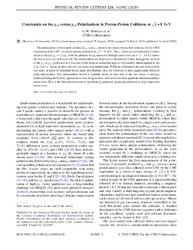Constraints on the χ c1 versus χ c2 polarizations in proton-proton collisions at √s = 8 TeV
| dc.contributor.author | Sirunyan, A. M. | |
| dc.contributor.author | Işıldak, Bora | |
| dc.date.accessioned | 2020-12-14T09:50:43Z | |
| dc.date.available | 2020-12-14T09:50:43Z | |
| dc.date.issued | 2020-04-24 | |
| dc.identifier.issn | 0031-9007 | en_US |
| dc.identifier.uri | http://hdl.handle.net/10679/7189 | |
| dc.identifier.uri | https://journals.aps.org/prl/abstract/10.1103/PhysRevLett.124.162002 | |
| dc.description.abstract | The polarizations of promptly produced chi(c1) and chi(c2) mesons are studied using data collected by the CMS experiment at the LHC, in proton-proton collisions at root s = 8 TeV. The chi(c) states are reconstructed via their radiative decays chi(c) -> J/psi gamma, with the photons being measured through conversions to e(+)e(-), which allows the two states to be well resolved. The polarizations are measured in the helicity frame, through the analysis of the chi(c2) to chi(c1) yield ratio as a function of the polar or azimuthal angle of the positive muon emitted in the J/psi -> mu(+)mu(-) decay, in three bins of J/psi transverse momentum. While no differences are seen between the two states in terms of azimuthal decay angle distributions, they are observed to have significantly different polar anisotropies. The measurement favors a scenario where at least one of the two states is strongly polarized along the hclicity quantization axis, in agreement with nonrelativistic quantum chromodynamics predictions. This is the first measurement of significantly polarized quarkonia produced at high transverse momentum. | en_US |
| dc.description.sponsorship | BMBWF and FWF (Austria); FNRS and FWO (Belgium); CNPq, CAPES, FAPERJ, FAPERGS, and FAPESP (Brazil); MES (Bulgaria); CERN; CAS, MoST, and NSFC (China); COLCIENCIAS (Colombia); MSES and CSF (Croatia); RPF (Cyprus); SENESCYT (Ecuador); MoER, ERC IUT, PUT and ERDF (Estonia); Academy of Finland, MEC, and HIP (Finland); CEA and CNRS/IN2P3 (France); BMBF, DFG, and HGF (Germany); GSRT (Greece); NKFIA (Hungary); DAE and DST (India); IPM (Iran); SFI (Ireland); INFN (Italy); MSIP and NRF (Republic of Korea); MES (Latvia); LAS (Lithuania); MOE and UM (Malaysia); BUAP, CINVESTAV, CONACYT, LNS, SEP, and UASLP-FAI (Mexico); MOS (Montenegro); MBIE (New Zealand); PAEC (Pakistan); MSHE and NSC (Poland); FCT (Portugal); JINR (Dubna); MON, RosAtom, RAS, RFBR, and NRC KI (Russia); MESTD (Serbia); SEIDI, CPAN, PCTI, and FEDER (Spain); MOSTR (Sri Lanka); Swiss Funding Agencies (Switzerland); MST (Taipei); ThEPCenter, IPST, STAR, and NSTDA (Thailand); TUBITAK and TAEK (Turkey); NASU (Ukraine); STFC (United Kingdom); DOE and NSF (USA). | |
| dc.language.iso | eng | en_US |
| dc.publisher | American Physical Society | en_US |
| dc.relation.ispartof | Physical Review Letters | |
| dc.rights | openAccess | |
| dc.title | Constraints on the χ c1 versus χ c2 polarizations in proton-proton collisions at √s = 8 TeV | en_US |
| dc.type | Article | en_US |
| dc.description.version | Publisher version | en_US |
| dc.peerreviewed | yes | en_US |
| dc.publicationstatus | Published | en_US |
| dc.contributor.department | Özyeğin University | |
| dc.contributor.authorID | (ORCID 0000-0002-0283-5234 & YÖK ID 124605) Işıldak, Bora | |
| dc.contributor.ozuauthor | Işıldak, Bora | |
| dc.creator | The CMS Collaboration | |
| dc.identifier.volume | 124 | en_US |
| dc.identifier.issue | 16 | en_US |
| dc.identifier.wos | WOS:000528518000007 | |
| dc.identifier.doi | 10.1103/PhysRevLett.124.162002 | en_US |
| dc.identifier.scopus | SCOPUS:2-s2.0-85084721870 | |
| dc.contributor.authorMale | 1 | |
| dc.relation.publicationcategory | Article - International Refereed Journal - Institutional Academic Staff |
Files in this item
This item appears in the following Collection(s)
Share this page



